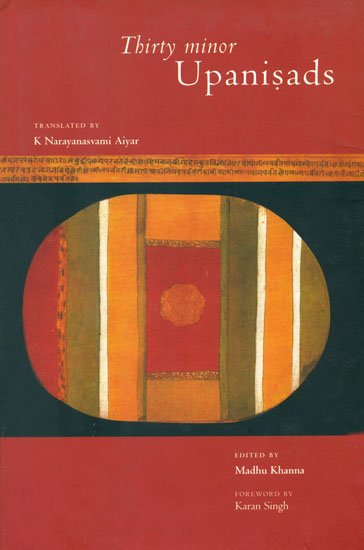Thirty minor Upanishads
by K. Narayanasvami Aiyar | 1914 | 95,228 words
This book contains the English translation of thirty minor Upanishads.—Fourteen belonging to Vedanta, two are categorised as Physiological, three are Mantra, two are Sannyasa and the remaining nine are categorised as Yoga-Upanishads. These Upanishads are properly defined as the Aranya-portion of the Vedas (most ancient Hindu scriptures) and are so-...
Tejobindu Upanishad of Krishna-yajurveda, Chapter II
Then the Kumāra[1] asked Śiva: "Please explain to me the nature of Cinmātra, that is the partless non-dual essence." The great Śiva replied: "The partless non-dual essence is the visible. It is the world, it is the existence, it is the Self, it is mantra, it is action, it is spiritual wisdom, it is water. It is the earth, it is ākāś, it is the books, it is the three Vedas, it is the Brahman, it is the religious vow, it is Jīva, it is Aja (the unborn), it is Brahma, it is Viṣṇu, it is Rudra; it is I, it is Ātma, it is the Guru. It is the aim, it is sacrifice, it is the body, it is manas, it is citta, it is happiness, it is vidyā; it is the undifferentiated, it is the eternal, it is the supreme, it is everything. O six-faced one, different from It there is nothing. None, none but It; It is I. It is gross, it is subtle, it is knowable, it is thou; it is the mysterious; it is the knower; it is existence, it is mother, it is father, it is brother, it is husband, it is Sūtra (Ātmā), it is Virāt. It is the body, it is the head, it is the internal, it is the external, it is full, it is nectar, it is gotra (clan), it is gṛha (the house), it is the preservable, it is the moon, it is the stars, it is the sun, it is the holy seat. It is forgiveness, it is patience, it is the guṇas, it is the witness. It is a friend, it is a relative, it is an ally, it is the king, town, kingdom and subjects. It is Om, japa, meditation, the seat, the one worthy to be taken (in), the heart, the Jyotis, Swarga (heaven) and Self."
"All the partless and non-dual essence should be regarded as Cinmātra. Cinmātra alone is the Absolute Consciousness; and this partless non-dual essence alone is the (real) essence. All having consciousness alone except those having changes, are Cinmātra. All this is Cinmātra. He is Cinmaya; the state of Ātmā is known as Cinmātra and the partless non-dual essence. The whole world is Cinmātra. Your state and my state are Cinmātra. Ākāś, earth, water, vāyu, agni, Brahmā, Viṣṇu, Śiva and all else that exist or do not, are Cinmātra. That which is the partless non-dual essence is Cinmātra. All the past, present, and future are Cinmātra. Substance and time are Cinmātra. Knowledge and the knowable are Cinmātra. The knower is Cinmātra. Everything is Cinmātra. Every speech is Cinmātra. Whatever else is Cinmātra. Asat and Sat are Cinmātra. The beginning and end are Cinmātra; that which is in the beginning and end is Cinmātra ever. The Guru and the disciple are Cinmātra. If the seer and the seen are Cinmātra, then they are always Cinmaya. All things wondrous are Cinmātra. The (gross) body is Cinmātra, as also the subtle and causal bodies. There is nothing beyond Cinmātra. I and thou are Cinmātra. Form and non-form are Cinmātra. Virtue and vice are Cinmātra. The body is a symbol of Cinmātra. Saṅkalpa, knowing, mantra, and others, the gods invoked in mantras, the gods presiding over the eight quarters, the phenomenal and the supreme Brahman are nothing but Cinmātra. There is nothing without Cinmātra. Māyā is nothing without Cinmātra. Pūjā (worship) is nothing without Cinmātra. Meditation, truth, sheaths and others, the (eight) valus, silence, non-silence, and indifference to objects—are nothing without Cinmātra. Everything is from Cinmātra. Whatever is seen and however seen—it is Cinmātra so far. Whatever exists and however distant, is Cinmātra. Whatever elements exist, whatever is perceived, and whatever is vedānta—all these are Cinmātra. Without Cinmātra, there is no motion, no Mokṣa and no goal aimed at. Everything is Cinmātra. Brahman that is the partless non-dual essence is known to be nothing but Cinmātra. Thou, O Lord, art the partless non-dual essence (stated) in the books, in me, in Thee, and in the ruler. He who thus perceives 'I' as of one homogeneity (pervading everywhere) will at once be emancipated through this spiritual wisdom. He is his own Guru with this profound spiritual wisdom. Thus ends the second chapter of Tejobindu."
